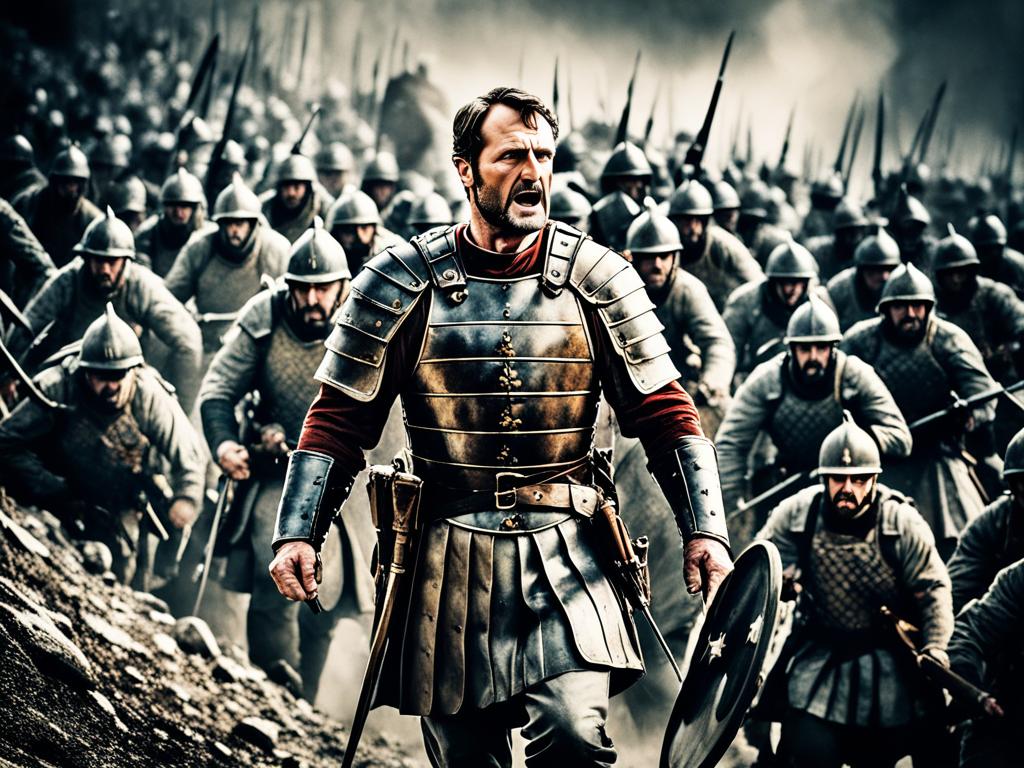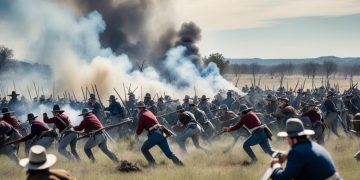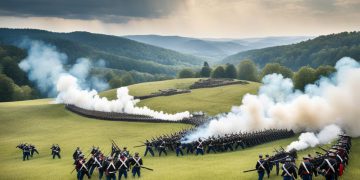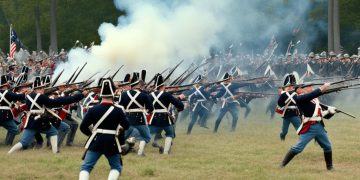Welcome to an exploration of one of history’s most legendary military commanders – General Hannibal. Known for his strategic brilliance and audacious tactics, Hannibal is renowned for his epic Alpine crossing and his profound impact on military history. In this article, we will uncover the fascinating life of Hannibal, his remarkable battles, innovative strategies, and enduring legacy. From his early life and military training to his iconic march across the Alps, join us on this thrilling journey to discover the extraordinary world of General Hannibal.
Key Takeaways:
- General Hannibal was a renowned military leader known for his strategic brilliance and audacious tactics.
- His epic march across the Alps is one of the most daring and famous military feats in history.
- Hannibal’s innovative use of war elephants and his focus on exploiting enemy weaknesses set him apart as a formidable opponent.
- His major battles, including the Battle of Cannae, showcased his tactical genius and resulted in significant victories.
- General Hannibal’s legacy has had a lasting impact on military history and has influenced subsequent commanders throughout the ages.
Hannibal’s Early Life and Military Training
In this section, we will delve into General Hannibal’s upbringing, his military training, and the experiences that shaped his strategic mindset.
Upbringing and Background
General Hannibal, born in 247 BC in Carthage, grew up in a family immersed in military and political affairs. His father, Hamilcar Barca, was a distinguished Carthaginian general, known for his victories against Rome in the First Punic War. It was within this environment that Hannibal’s passion for warfare was ignited.
From a young age, Hannibal displayed exceptional intelligence and leadership skills. His father nurtured these talents, emphasizing the importance of military education and instilling in him a deep sense of patriotism for Carthage.
Military Training and Influences
Hannibal’s formal military training began at an early age. He learned the art of warfare from his father, observing his strategic decision-making and studying his successful campaigns. This upbringing greatly influenced Hannibal’s tactical thinking and shaped his ambition to avenge his homeland against Rome.
In addition to his father’s guidance, Hannibal received training from veteran Carthaginian officers who had fought alongside Hamilcar in previous conflicts. These mentors further honed his skills in military strategy, logistics, and the art of leading troops.
Experiences and Formative Years
As Hannibal grew older, he was exposed to the reality of the Roman threat and the desire to restore Carthaginian supremacy. His experiences witnessing the aftermath of the First Punic War and the harsh terms imposed on Carthage fueled his determination to challenge Rome’s dominance.
During his teenage years, Hannibal witnessed the impact of Roman expansionism, including Rome’s annexation of Sardinia and Corsica, traditional Carthaginian territories. These events deepened his resolve to avenge his people and reclaim their lost lands.
“I swear an oath that I will forever be an enemy to Rome.” – Hannibal
The Epic March Across the Alps
General Hannibal’s audacious decision to cross the treacherous Alps with his army was a pivotal moment in military history. The epic journey, known as The Epic March Across the Alps, presented numerous challenges and showcased General Hannibal’s remarkable leadership and strategic brilliance.
Undeterred by the daunting terrain and harsh weather conditions, General Hannibal led his army, consisting of infantry, cavalry, and war elephants, through the icy mountain passes. The treacherous slopes tested their endurance and resilience, but Hannibal’s unwavering determination propelled them forward.
The March Across the Alps was a groundbreaking military maneuver that caught his adversaries off guard. By taking this unconventional route, Hannibal exhibited his ability to think outside the box and exploit his enemy’s vulnerabilities. It allowed him to surprise and overwhelm the Roman forces, turning the tide of the war in his favor.
The Challenges Faced:
The daunting Alps presented a myriad of challenges, making the journey perilous and demanding. Hannibal and his army had to navigate steep and narrow paths, battle hostile local tribes, overcome freezing temperatures, and traverse treacherous snow-covered peaks.
“I will find a way or make one.” – General Hannibal
These formidable obstacles required creative solutions and immense courage. General Hannibal’s ability to adapt to the changing circumstances and motivate his troops proved crucial in their successful passage through the Alps.
The Impact on Hannibal’s Campaigns:
The Epic March Across the Alps had a profound impact on General Hannibal’s campaigns. It demonstrated his audacity and resourcefulness, bolstering the morale of his troops and intimidating his enemies. The successful crossing established Hannibal as a daring and unconventional commander, earning the respect and admiration of his soldiers.
Furthermore, the Alps crossing strategically positioned Hannibal’s army behind enemy lines, enabling him to launch swift and devastating attacks on Roman territories. This strategic advantage allowed him to score major victories and sustain his military campaign in Italy for over a decade.
General Hannibal’s daring feat of leading his army across the Alps remains one of the most iconic and renowned military achievements in history. It solidified his reputation as a brilliant tactician and forever changed the dynamics of warfare.
The image depicts the awe-inspiring landscape of the Alps, highlighting the immense challenges faced by General Hannibal and his army during their historic crossing.
Major Battles Led by Hannibal
One of the hallmarks of General Hannibal’s military career was his remarkable success in numerous major battles. His strategic brilliance and tactical acumen allowed him to achieve stunning victories against formidable enemies. Two notable battles that showcased his extraordinary leadership and military skills were the Battle of Cannae and the Battle of Trebbia.
In the Battle of Cannae, which took place in 216 BCE during the Second Punic War, General Hannibal’s Carthaginian forces confronted a much larger Roman army. Employing innovative tactics and exploiting the weaknesses of the Roman formation, Hannibal orchestrated a devastating encirclement, resulting in one of the most catastrophic defeats in Roman history. The outcome of the battle demonstrated Hannibal’s ability to outmaneuver and outthink his opponents, solidifying his reputation as a strategic genius.
Another significant battle led by Hannibal was the Battle of Trebbia in 218 BCE. Facing the Roman army under Sempronius Longus, Hannibal capitalized on the harsh winter conditions to surprise and overpower the Roman forces. Through preemptive maneuvers and a combination of cavalry charges and infantry assaults, Hannibal achieved a decisive victory, inflicting heavy casualties on the Romans and further bolstering his strategic prowess.
These major battles led by General Hannibal not only showcased his tactical brilliance and military genius, but also demonstrated his ability to defeat larger and more established forces. His victories in these battles remain extraordinary examples of strategic warfare and have left an indelible mark on military history.
Hannibal’s Strategies and Tactics
General Hannibal was renowned for his strategic brilliance and tactical prowess on the battlefield. His innovative approaches and ability to exploit the weaknesses of his enemies set him apart as one of history’s most formidable military commanders.
One of Hannibal’s most notable strategies was his innovative use of war elephants. These towering beasts instilled fear in his opponents and provided him with a significant advantage on the battlefield. The elephants, armed with deadly tusks and capable of trampling enemies, created chaos among enemy ranks, breaking their formations and opening opportunities for Hannibal’s forces to attack.
But Hannibal’s strategies extended beyond the use of war elephants. He was a master at adapting to different terrains and exploiting the enemy’s weaknesses. Whether it was navigating the treacherous Alps or formulating surprise attacks, Hannibal’s ability to analyze his surroundings and make strategic decisions accordingly allowed him to constantly stay one step ahead of his adversaries.
“We will either find a way, or make one.” – Hannibal
Hannibal’s tactical brilliance was perhaps best demonstrated in the Battle of Cannae. Facing a much larger Roman army, he devised a unique double-envelopment strategy, luring the enemy into his trap. By creating a concave formation, Hannibal’s forces effectively surrounded and decimated the Roman army, causing one of the deadliest defeats in ancient warfare.
In addition to his military maneuvers, Hannibal understood the importance of morale and motivation. He fostered strong bonds within his army and instilled a sense of loyalty and dedication among his soldiers. This cohesion and unity on the battlefield contributed to his successes, as his troops fought with unwavering determination.
Overall, General Hannibal’s strategies and tactics were characterized by their innovation, adaptability, and ability to exploit weaknesses. His use of war elephants, his prowess in navigating challenging terrains, and his tactical brilliance in battles like Cannae solidify his place among history’s greatest military leaders.
The Legacy of Hannibal in Military History
General Hannibal’s remarkable legacy in military history is undeniable. His brilliant military strategies and tactical genius continue to inspire and influence subsequent military leaders even to this day. Hannibal’s enduring reputation as one of the greatest commanders of all time is a testament to the profound impact he had on the art of warfare.
Throughout history, military leaders have studied Hannibal’s campaigns and gleaned valuable insights from his innovative tactics. His ability to adapt and overcome challenges, such as his daring Alpine crossing, showcased his audacity and willingness to take risks. These traits have served as an inspiration for generations of military commanders who seek to achieve victory against all odds.
Hannibal’s strategic mindset and attention to detail are legendary. He possessed a keen understanding of his enemies’ weaknesses and exploited them to his advantage. His unconventional use of war elephants in battle, such as in the famous Battle of Cannae, remains a topic of study and analysis by military historians.
Not only did Hannibal leave a lasting impact on the battlefield, but his campaigns also had significant geopolitical ramifications. The Second Punic War, in which he played a central role, forever altered the power dynamics between Rome and Carthage. Hannibal’s relentless attacks on Rome challenged the prevailing notion of Roman invincibility and forced the Republic to adopt new defensive strategies.
Hannibal’s enduring legacy can be seen in the strategies employed by subsequent military leaders. His teachings on leadership, adaptability, and exploiting enemy weaknesses continue to shape military doctrines around the world. The lessons learned from Hannibal’s military campaigns serve as a timeless reminder of the importance of strategic thinking, innovation, and courage in the face of adversity.
Influence on Subsequent Military Leaders
Hannibal’s genius has been acknowledged and studied by renowned military leaders throughout history. Notable commanders such as Napoleon Bonaparte, Robert E. Lee, and Erwin Rommel have openly praised Hannibal’s tactics and sought to emulate his achievements. They recognized the timeless value of his strategies and incorporated them into their own military campaigns.
“I would rather have Hannibal on my side than against me.” – Napoleon Bonaparte
These influential leaders recognized that studying Hannibal’s tactics could provide them with a competitive edge on the battlefield. Hannibal’s strategic brilliance continues to serve as a source of inspiration for military leaders, demonstrating that innovation, adaptability, and perseverance are the keys to victory.
Military Leaders Inspired by Hannibal
| Commander | Achievements |
|---|---|
| Napoleon Bonaparte | Conqueror of Europe, French military genius |
| Robert E. Lee | Confederate General during the American Civil War |
| Erwin Rommel | German Field Marshal, known as the “Desert Fox” |
General Hannibal’s legacy in military history remains unparalleled. His strategic brilliance, innovative tactics, and audacious campaigns have secured his place among the greatest military leaders of all time. His lasting influence on subsequent military commanders and his profound impact on the art of warfare are a testament to his enduring legacy.
Hannibal’s Impact on Rome and Carthage
General Hannibal’s campaigns had far-reaching consequences for both Rome and Carthage, profoundly shaping the course of history and power dynamics in the ancient world. The lasting impact of Hannibal’s military endeavors on these two empires cannot be overstated.
In Rome, Hannibal’s relentless attacks and strategic victories struck fear into the hearts of its citizens and threatened the very existence of the Roman Republic. The Roman Senate mobilized its forces and allocated significant resources to counter Hannibal’s advances, resulting in a series of devastating battles that tested the Roman military to its limits.
“I shall either find a way or make one.” – Hannibal
The epic confrontation between Hannibal and Rome, most notably at the Battle of Cannae, highlighted the Carthaginian general’s tactical brilliance and the vulnerabilities of the Roman Republic. The Roman losses in these battles were staggering, with tens of thousands of soldiers and numerous high-ranking officials falling victim to Hannibal’s masterful strategies.
As Hannibal ravaged the Italian peninsula, Rome faced a dire situation that demanded desperate measures. Appius Claudius Pulcher, a Roman consul, spearheaded efforts to rally support and strengthen the Roman army. These efforts led to the replenishment of troops and the appointment of experienced generals such as Fabius Maximus, who employed a different strategy altogether and adopted a defensive approach.
Despite Rome’s resilience and eventual victory in the Second Punic War, Hannibal’s impact on the city’s psyche persisted. The memory of the general’s audacious exploits and the sense of vulnerability caused lasting apprehension in the Roman collective consciousness.
For Carthage, while Hannibal initially achieved significant success, the prolonged conflict and the eventual loss in the Second Punic War proved catastrophic. Carthage suffered enormous casualties, economic decline, and the loss of its territorial holdings in Spain and parts of North Africa.
The Punic Wars between Rome and Carthage, largely ignited by Hannibal’s audacious march across the Alps, reshaped the balance of power in the Mediterranean. With the defeat of Carthage and the ascendancy of Rome, the Roman Republic emerged as the dominant force in the region, laying the foundation for the Roman Empire.
Hannibal’s Impact on Rome and Carthage – A Comparison
| Rome | Carthage |
|---|---|
| Severe military losses and casualties | Devastating territorial losses in Spain and North Africa |
| Economic strain and resource depletion | Crippling economic decline |
| Heightened collective consciousness of vulnerability | Loss of military prestige and regional power |
| Shift in power dynamics in the Mediterranean | Emergence of Rome as the dominant force |
The impact of Hannibal’s campaigns reverberated throughout history, serving as a testament to his tactical genius and the enduring legacy he left behind. The strategic lessons learned from Hannibal’s methods continue to influence military leaders and historians to this day, cementing his place as one of the greatest commanders in history.
Conclusion
Throughout this article, we have explored the remarkable life and achievements of General Hannibal. From his early years and military training to his audacious Alpine crossing, Hannibal’s legacy as one of the greatest military leaders in history is undeniable.
His tactical brilliance and innovative strategies, such as his effective use of war elephants and exploitation of enemy weaknesses, set him apart from his contemporaries.
General Hannibal’s major battles, including the iconic Battle of Cannae, showcased his mastery of unconventional warfare tactics and his ability to outmaneuver and outwit his adversaries.
The impact of Hannibal’s campaigns reverberated far beyond his own time, shaping the course of military history and influencing subsequent leaders for centuries. His enduring legacy continues to inspire and captivate scholars, historians, and military enthusiasts around the world.







